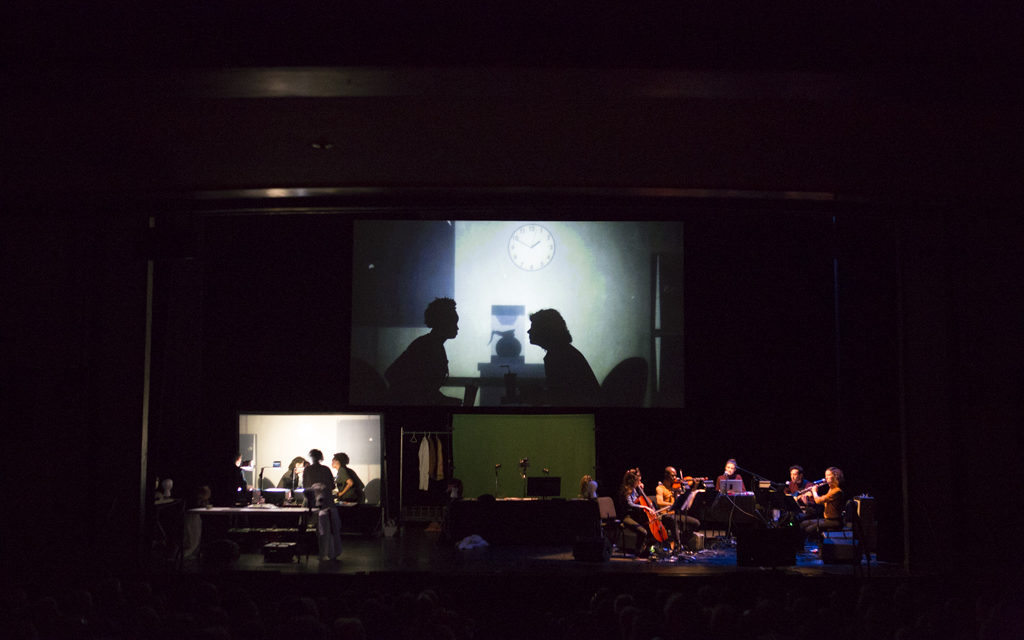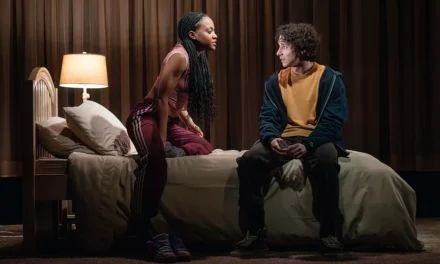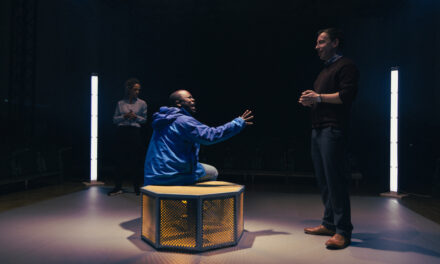ArtsEmerson, Boston’s hub for international, experimental, and cutting-edge theatre, has invited for a second time in a year the Chicago-based Manual Cinema to present their latest multimedia stage production, The End Of TV, directed by Julia VanArsdale Miller. The show is nothing short of mesmerizing. The company crafts together a kaleidoscope of puppetry, music, and film to deliver a surprisingly intimate story of two women struggling to find connection.
One of the joys of a Manual Cinema production is watching the film side by side with its very creation. As the film tells a story of age, loneliness, loss, consumerism, desolation, and new beginnings projected on a screen, the company of artists, musicians, puppeteers, and performers on stage tirelessly change slides, switch puppets, swap clothes, add wigs, don masks, and rush from station to station to ensure the smooth flow of the images. The film that is created hangs fifteen feet above their heads as they work. It moves seamlessly as if captured, edited, polished, and projected like any other film, but the audience never loses sight of the process. Even the music is performed live—an entrancing original score by Ben Kauffman and Kyle Vegter inspired by 70s R&B art pop music. There is hardly a single element left invisible to the audience as it gets to see every piece culminate into a beautiful whole.
The simultaneity of all the different components forces the audience into a reckoning, one that is constant. Do I watch the screen where the story is being told? Or do I watch the company of puppeteers, technicians, and musicians, where the action is taking place? The coupling here is striking. A spectacular feat of teamwork, where a company of talented artists strive to create a singular work, and at the same time a tale of almost hopeless loneliness seen on the screen. The audience witnesses the artists, as a community, doing work that is purely analog, while the characters in the story live their lives through increasing technological isolation.
The story centers on the lives of two women living in a post-industrial Rust Belt city in the 1990s. Flo (Kara Davidson) is an elderly white woman suffering from the late stages of dementia. Her life is a stagnant one as she stares endlessly at a television, what seems to be her only connection to the outside world. Her favorite channel, QVC, consumes her as she slavishly purchases all manner of appliances, remedy, and tchotchke. Her house is filled with boxes, many unopened. As they mount and begin to block passageways, these packages threaten Flo as much as they fill a vacuum in her life. When the effects of dementia strike most acutely, she falls into a panic, and her reality switches like a channel, into a surrealistic nightmare where television and reality scramble together. Manual Cinema uses the quick cuts, juxtaposition, and overwhelming nature of channel searching to evoke Flo’s disorientation. Her memories mix with the static, advertising cartoon mascots (most notably the Jolly Green Giant), and sound clips from the television that continually haunts her existence.
Alongside Flo is the story of Louise (Sharaina L. Turnage), a young black woman who has just lost her job at a recently closed factory—incidentally, the same factory Flo used to work at. Like Flo, Louise lives alone. She spends her hours looking for work, pushing back memories of a contentious life with her father. Eventually, she finds a job as a delivery driver for Meals on Wheels, which brings her to Flo. Louise proves to be a saving grace to Flo as the two bonds over unexpressed but ever-apparent loneliness. Louise is the only person who seems to care for Flo in the last moments of her life. Watching Flo’s degeneration only seems to ignite a sense of re-discovery in Louise.
We only see Flo and Louise as silent shadows. Through a marvelous effect, their personages are created by actors in masks who move in silhouette against a backdrop. Though the audience watches real people move and emote on stage, on screen the same individuals look like drawings on a piece of paper, almost as if animated. The only “real” people the audience sees and hears are those in the recreated 90s commercials and television clips, played by Vanessa S. Valliere and Jeffrey Paschal. The ensemble performs these commercials by lip-syncing actual dialogue and hamming up the characters with unabashed kitsch. What is striking is that these real, flesh and blood images in full color always feel less than human. Yet, Manual Cinema creates vivid emotions through the two-dimensional shadows.
There is another layer, too, in that the audience has the opportunity to watch the company work on stage without any filtration whatsoever. Yet, the company’s focus is never toward the audience. They remain attuned to the artistic creation. Their work is evocative of Plato’s allegory of the cave, where puppet-masters create an illusory reality for the shackled prisoners, whose only connection to the outside world are shadows on the wall. The prisoners mistake these shadows as reality, but they are, of course, falsities. But Manual Cinema’s The End Of TV does the opposite. Its shadows speak truth.
There is also a Marxist message here about consumerism, about the alienation of the laborer, about the divorce of human experience as it becomes increasingly mediated through technologies, such as television. Flo almost lives her entire existence through a television. As her perceptions become filled with the iconography of commercials and broadcasts, her home similarly piles up with the materials of a capitalistic existence, none that signify any real value or connection to human life. At watching Flo’s isolation, Louise gets inspired to dig up the yard, plant a garden, and repair homes in her dilapidated neighborhood. She begins to see value in the tangible connection, her worth through labor done by hand and for the immediate benefit of those around her.
Manual Cinema chooses to share this message through a paradoxical presentation. One that is through pure mediation and projection, stories of image told through technology (the only kind of reality Flo seems to know anymore). The other is of people working together on behalf of an audience in hopes of enriching their lives (the kind of reality Louise rediscovers). The images of The End Of TV are haunting and effective, and the production itself is quite unlike anything I have seen on stage. Through a crafty creation of live animation, Manual Cinema boldly asserts the live-ness and vitality of the stage.
Production by Manual Cinema. Now playing at ArtsEmerson. At Robert J. Orchard Stage, Paramount Center, Boston, through Jan. 27. Tickets $20-$80, 617-824-8400, www.artsemerson.org.
This post was written by the author in their personal capacity.The opinions expressed in this article are the author’s own and do not reflect the view of The Theatre Times, their staff or collaborators.
This post was written by Matthew McMahan.
The views expressed here belong to the author and do not necessarily reflect our views and opinions.


















